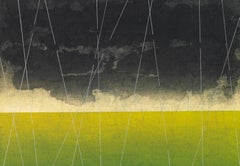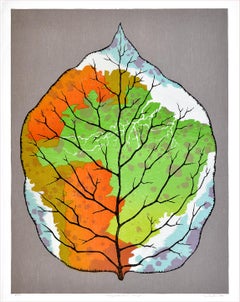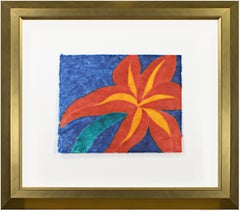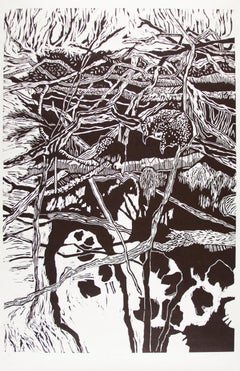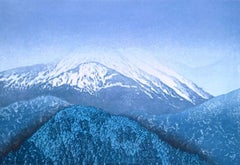Woodcut Landscape Prints
to
11
94
26
10
23
57
55
22
41
41
11
29
12
Overall Height
to
Overall Width
to
99
7
2
2
1
15
14
14
13
12
12
10
10
7
6
6
5
5
5
5
5
5
4
4
4
6
98
439
134
5
14
44
43
16
33
129
13
17
10
3
33
18
6
4
4
4,874
1,560
1,096
870
825
Period: 21st Century and Contemporary
Medium: Woodcut
Keiji Shinohara, Accelerondo, Ukiyo-e woodcut print landscape, 2005
Located in New York, NY
Keiji Shinohara was born and raised in Osaka, Japan. After 10 years as an apprentice to the renowned Keiichiro Uesugi in Kyoto, he became a Master Printmaker and moved to the United ...
Category
21st Century and Contemporary Abstract Woodcut Landscape Prints
Materials
Paper, Woodcut
Brazilian Rainforest
Located in Lyons, CO
Color woodcut, Edition 25.
Morinoue first observed the Brazilian rainforest in 1997 when the exhibition he designed, The Kona Coffee Story: Along the Hawai'i Belt Road, was shown in...
Category
2010s Contemporary Woodcut Landscape Prints
Materials
Woodcut
'Narcissus Braziliana' original woodcut & monotype signed by Carol Summers
Located in Milwaukee, WI
The present artwork is a vibrant and colorful example of the woodcut prints of Carol Summers. The image is dominated by the form of a red tropical flower, closely cropped around the petals like in the photographs of Imogen Cunningham and the paintings of Georgia O'Keeffe. The playfulness of the image is enhanced by Summers' signature printmaking technique, which allows the ink from the woodblock to seep through the paper, blurring the edges of each form.
9.63 x 11.63 inches, artwork
21 x 23 inches, frame
Edition 16/50 in pencil, lower right
Titled in pencil, lower right
Signed in pencil, lower center
Framed to conservation standards using archival materials including 100 percent rag matting, Museum Glass to inhibit fading, and housed in a modern profile gold gilded wood moulding.
Carol Summers (1925-2016) has worked as an artist throughout the second half of the 20th century and into the first years of the next, outliving most of his mid-century modernist peers. Initially trained as a painter, Summers was drawn to color woodcuts around 1950 and it became his specialty thereafter. Over the years he has developed a process and style that is both innovative and readily recognizable. His art is known for it’s large scale, saturated fields of bold color, semi-abstract treatment of landscapes from around the world and a luminescent quality achieved through a printmaking process he invented.
In a career that has extended over half a century, Summers has hand-pulled approximately 245 woodcuts in editions that have typically run from 25 to 100 in number. His talent was both inherited and learned. Born in 1925 in Kingston, a small town in upstate New York, Summers was raised in nearby Woodstock with his older sister, Mary. His parents were both artists who had met in art school in St. Louis. During the Great Depression, when Carol was growing up, his father supported the family as a medical illustrator until he could return to painting. His mother was a watercolorist and also quite knowledgeable about the different kinds of papers used for various kinds of painting. Many years later, Summers would paint or print on thinly textured paper originally collected by his mother.
From 1948 to 1951, Carol Summers trained in the classical fine and studio arts at Bard College and at the Art Students League of New York. He studied painting with Steven Hirsh and printmaking with Louis Schanker. He admired the shapes and colors favored by early modernists Paul Klee (Sw: 1879-1940) and Matt Phillips (Am: b.1927- ). After graduating, Summers quit working as a part-time carpenter and cabinetmaker (which had supported his schooling and living expenses) to focus fulltime on art. That same year, an early abstract, Bridge No. 1 was selected for a Purchase Prize in a competition sponsored by the Brooklyn Museum.
In 1952, his work (Cathedral, Construction and Icarus) was shown the first time at the Museum of Modern Art in New York City in an exhibition of American woodcuts. In 1954, Summers received a grant from the Italian government to study for a year in Italy. Woodcuts completed soon after his arrival there were almost all editions of only 8 to 25 prints, small in size, architectural in content and black and white in color. The most well-known are Siennese Landscape and Little Landscape, which depicted the area near where he resided. Summers extended this trip three more years, a decision which would have significant impact on choices of subject matter and color in the coming decade.
After returning from Europe, Summers’ images continued to feature historical landmarks and events from Italy as well as from France, Spain and Greece. However, as evidenced in Aetna’s Dream, Worldwind and Arch of Triumph, a new look prevailed. These woodcuts were larger in size and in color. Some incorporated metal leaf in the creation of a collage and Summers even experimented with silkscreening. Editions were now between 20 and 50 prints in number. Most importantly, Summers employed his rubbing technique for the first time in the creation of Fantastic Garden in late 1957.
Dark Vision of Xerxes, a benchmark for Summers, was the first woodcut where Summers experimented using mineral spirits as part of his printmaking process. A Fulbright Grant as well as Fellowships from the Louis Comfort Tiffany Foundation and the Guggenheim Foundation followed soon thereafter, as did faculty positions at colleges and universities primarily in New York and Pennsylvania. During this period he married a dancer named Elaine Smithers with whom he had one son, Kyle. Around this same time, along with fellow artist Leonard Baskin, Summers pioneered what is now referred to as the “monumental” woodcut. This term was coined in the early 1960s to denote woodcuts that were dramatically bigger than those previously created in earlier years, ones that were limited in size mostly by the size of small hand-presses. While Baskin chose figurative subject matter, serious in nature and rendered with thick, striated lines, Summers rendered much less somber images preferring to emphasize shape and color; his subject matter approached abstraction but was always firmly rooted in the landscape.
In addition to working in this new, larger scale, Summers simultaneously refined a printmaking process which would eventually be called the “Carol Summers Method” or the “ Carol Summers Technique”. Summers produces his woodcuts by hand, usually from one or more blocks of quarter-inch pine, using oil-based printing inks and porous mulberry papers. His woodcuts reveal a sensitivity to wood especially its absorptive qualities and the subtleties of the grain. In several of his woodcuts throughout his career he has used the undulating, grainy patterns of a large wood plank to portray a flowing river or tumbling waterfall. The best examples of this are Dream, done in 1965 and the later Flash Flood Escalante, in 2003. In the majority of his woodcuts, Summers makes the blocks slightly larger than the paper so the image and color will bleed off the edge.
Before printing, he centers a dry sheet of paper over the top of the cut wood block or blocks, securing it with giant clips. Then he rolls the ink directly on the front of the sheet of paper and pressing down onto the dry wood block or reassembled group of blocks. Summers is technically very proficient; the inks are thoroughly saturated onto the surface of the paper but they do not run into each other. The precision of the color inking in Constantine’s Dream in 1969 and Rainbow Glacier in 1970 has been referred to in various studio handbooks. Summers refers to his own printing technique as “rubbing”. In traditional woodcut printing, including the Japanese method, the ink is applied directly onto the block. However, by following his own method, Summers has avoided the mirror-reversed image of a conventional print and it has given him the control over the precise amount of ink that he wants on the paper. After the ink is applied to the front of the paper, Summers sprays it with mineral spirits, which act as a thinning agent. The absorptive fibers of the paper draw the thinned ink away from the surface softening the shapes and diffusing and muting the colors. This produces a unique glow that is a hallmark of the Summers printmaking technique. Unlike the works of other color field artists or modernists of the time, this new technique made Summers’ extreme simplification and flat color areas anything but hard-edged or coldly impersonal.
By the 1960s, Summers had developed a personal way of coloring and printing and was not afraid of hard work, doing the cutting, inking and pulling himself. In 1964, at the age of 38, Summers’ work was exhibited for a second time at the Museum of Modern Art. This time his work was featured in a one-man show and then as one of MoMA’s two-year traveling exhibitions which toured throughout the United States. In subsequent years, Summers’ works would be exhibited and acquired for the permanent collections of multiple museums throughout the United States, Europe and Asia. Summers’ familiarity with landscapes throughout the world is firsthand. As a navigator-bombardier in the Marines in World War II, he toured the South Pacific and Asia.
Following college, travel in Europe and subsequent teaching positions, in 1972, after 47 years on the East Coast, Carol Summers moved permanently to Bonny Doon in the Santa Cruz Mountains in Northern California. There met his second wife, Joan Ward Toth, a textile artist who died in 1998; and it was here his second son, Ethan was born. During the years that followed this relocation, Summers’ choice of subject matter became more diverse although it retained the positive, mostly life-affirming quality that had existed from the beginning. Images now included moons, comets, both sunny and starry skies, hearts and flowers, all of which, in one way or another, remained tied to the landscape.
In the 1980s, from his home and studio in the Santa Cruz mountains, Summers continued to work as an artist supplementing his income by conducting classes and workshops at universities in California and Oregon as well as throughout the Mid and Southwest. He also traveled extensively during this period hiking and camping, often for weeks at a time, throughout the western United States and Canada. Throughout the decade it was not unusual for Summers to backpack alone or with a fellow artist into mountains or back country for six weeks or more at a time. Not surprisingly, the artwork created during this period rarely departed from images of the land, sea and sky. Summers rendered these landscapes in a more representational style than before, however he always kept them somewhat abstract by mixing geometric shapes with organic shapes, irregular in outline. Some of his most critically acknowledged work was created during this period including First Rain, 1985 and The Rolling Sea, 1989. Summers received an honorary doctorate from his alma mater, Bard College in 1979 and was selected by the United States Information Agency to spend a year conducting painting and printmaking workshops at universities throughout India. Since that original sabbatical, he has returned every year, spending four to eight weeks traveling throughout that country.
In the 1990s, interspersed with these journeys to India have been additional treks to the back roads and high country areas of Mexico, Central America, Nepal, China and Japan. Travel to these exotic and faraway places had a profound influence on Summers’ art. Subject matter became more worldly and non-western as with From Humla to Dolpo, 1991 or A Former Life of Budha, 1996, for example. Architectural images, such as The Pillars of Hercules, 1990 or The Raja’s Aviary, 1992 became more common. Still life images made a reappearance with Jungle Bouquet in 1997. This was also a period when Summers began using odd-sized paper to further the impact of an image.
The 1996 Night, a view of the earth and horizon as it might be seen by an astronaut, is over six feet long and only slightly more than a foot-and-a-half high. From 1999, Revuelta A Vida (Spanish for “Return to Life”) is pie-shaped and covers nearly 18 cubic feet. It was also at this juncture that Summers began to experiment with a somewhat different palette although he retained his love of saturated colors. The 2003 Far Side of Time is a superb example of the new direction taken by this colorist.
At the turn of the millennium in 1999, “Carol Summers Woodcuts...
Category
Early 2000s Contemporary Woodcut Landscape Prints
Materials
Monotype, Woodcut
Sommesso II, blue and gray Ukiyo-e landscape woodblock print, 2016
Located in New York, NY
Keiji Shinohara was born and raised in Osaka, Japan. After 10 years as an apprentice to the renowned Keiichiro Uesugi in Kyoto, he became a Master Printmaker and moved to the United ...
Category
2010s Contemporary Woodcut Landscape Prints
Materials
Woodcut
Big Bird's Nest
By Michael Rich
Located in Fairfield, CT
This piece is unframed.
Category
2010s Abstract Woodcut Landscape Prints
Materials
Woodcut
Blue, Ukiyo-e landscape woodcut print, 2014
Located in New York, NY
Keiji Shinohara was born and raised in Osaka, Japan. After 10 years as an apprentice to the renowned Keiichiro Uesugi in Kyoto, he became a Master Printmaker and moved to the United ...
Category
2010s Contemporary Woodcut Landscape Prints
Materials
Woodcut
Fuji From Shinjuku
Located in Palm Springs, CA
Signed and numbered color woodcut from the edition of 22. Modern woman with umbrella in the Shinjuku ward of Tokyo; Mount Fuji can be seen in the distance above the rooftops
Art Hazelwood calls himself artist, instigator and impresario to define the three intertwining areas of his practice. He uses printmaking within a range of political allegory and satire making work from political posters to fine press edition artist books. He has curated and organized a range of exhibitions at venues from museums to immigrant centers. He has worked for over 20 years with homeless rights groups; creating prints, and street posters, and has authored one book and contributed to another on art and homelessness.
He has been a regular visiting guest artist at San Quentin State Prison and teaches currently at the San Francisco Art Institute. He organized the San Francisco Poster...
Category
2010s Contemporary Woodcut Landscape Prints
Materials
Woodcut
Cultured Woman - Tokyo
Located in Palm Springs, CA
Signed and numbered color woodcut from the edition of 15. Modern woman in Tokyo; signed and titled edition of 15.
Art Hazelwood calls himself artist, instigator and impresario to define the three intertwining areas of his practice. He uses printmaking within a range of political allegory and satire making work from political posters to fine press edition artist books. He has curated and organized a range of exhibitions at venues from museums to immigrant centers. He has worked for over 20 years with homeless rights groups; creating prints, and street posters, and has authored one book and contributed to another on art and homelessness.
He has been a regular visiting guest artist at San Quentin State Prison and teaches currently at the San Francisco Art Institute. He organized the San Francisco Poster...
Category
2010s Contemporary Woodcut Landscape Prints
Materials
Woodcut
Dragonfly Pond
Located in Lyons, CO
Color woodcut with pochoir, Edition 30
In all of Morinoue's work there is a compelling sense of place--the ocean shoreline, lava flows and Japanese gardens. He is a patient observ...
Category
21st Century and Contemporary Contemporary Woodcut Landscape Prints
Materials
Woodcut
"Red, Yellow, Blue & Green, " Color Woodcut & Monotype signed by Carol Summers
Located in Milwaukee, WI
"Red, Yellow, Blue & Green" is an original color woodcut by Carol Summers. The artist signed the piece in the lower left. This woodcut depicts four color fields. The edition number i...
Category
2010s Woodcut Landscape Prints
Materials
Monotype, Woodcut
Opus 9, landscape Ukiyo-e monotype, 2008
Located in New York, NY
In his Ukiyo-e monotype, Opus 9, 2011, Keiji Shinohara uses the tradition of landscape as a playground for his dialogue between eastern and western tradition. Shinohara's flattened s...
Category
Early 2000s Contemporary Woodcut Landscape Prints
Materials
Monoprint, Woodcut
Low Tide
Located in Lyons, CO
Color woodcut, Edition 30
The left panel of Low Tide captures the play of light on water with abstracted colorful reflections. The right panel depicts a tr...
Category
21st Century and Contemporary Contemporary Woodcut Landscape Prints
Materials
Woodcut
One Hundred Fifty Feet Down
Located in Dallas, TX
Eleanor Jones Harvey, Chief Curator at the Smithsonian American Art Museum, wrote about Bob Stuth-Wade:
“Over the course of his career, Bob Stuth-Wade has examined his responses t...
Category
21st Century and Contemporary Contemporary Woodcut Landscape Prints
Materials
Woodcut
Gwenda Morgan (1908-1991) - Framed Wood Engraving, Summer Kaleidoscope
Located in Corsham, GB
Gwenda Morgan (1908-1991)- limited edition wood engraving. Signed and titled in pencil to the lower margin. Editioned 10/50. Smartly mounted in a reeded oak frame. On paper.
Category
21st Century and Contemporary Woodcut Landscape Prints
Materials
Woodcut
Sunrise - forest, sunlight, woodcut
By Alex Katz
Located in Köln, DE
This work is not a typical landscape by Alex Katz. It is a very stunning, nearly abstract work which is made of a combination of printing techniques like woodcut, lithograph and scre...
Category
2010s Contemporary Woodcut Landscape Prints
Materials
Lithograph, Screen, Woodcut
Flags - woodcut, flowers, flags, Katz, black and white
By Alex Katz
Located in Köln, DE
"Flags" is a stunning woodcut from 2013. It is a very stylized view over a wide flower meadow. Typically, Katz is using a clear and straight color palette. It is beautiful to see how...
Category
2010s Contemporary Woodcut Landscape Prints
Materials
Woodcut
Tree 8
By Alex Katz
Located in Miami, FL
Technical Information:
Alex Katz
Tree 8
2022
Woodcut and Lithograph
39 3/4 x 39 1/4 in.
Edition of 60
Pencil signed and numbered
Category
21st Century and Contemporary Contemporary Woodcut Landscape Prints
Materials
Lithograph, Woodcut
"Nachtfahrt"
By Christiane Baumgartner
Located in Köln, DE
A wonderful and delicate portfolio by Christiane Baumgartner, artist from Leipzig/Germany. "Nachtfahrt" (night tour) consists of 9 woodcut prints on Zerkall laid paper. Each work has...
Category
Early 2000s Contemporary Woodcut Landscape Prints
Materials
Woodcut
Woodcut landscape prints for sale on 1stDibs.
Find a wide variety of authentic Woodcut landscape prints available on 1stDibs. While artists have worked in this medium across a range of time periods, art made with this material during the 21st Century is especially popular. If you’re looking to add landscape prints created with this material to introduce a provocative pop of color and texture to an otherwise neutral space in your home, the works available on 1stDibs include elements of blue, orange, yellow, green and other colors. There are many well-known artists whose body of work includes ceramic sculptures. Popular artists on 1stDibs associated with pieces like this include Marc Zimmerman, Eve Stockton, Carol Summers, and Utagawa Hiroshige. Frequently made by artists working in the Modern, Contemporary, all of these pieces for sale are unique and many will draw the attention of guests in your home. Not every interior allows for large Woodcut landscape prints, so small editions measuring 0.01 inches across are also available
Recently Viewed
View AllMore Ways To Browse
Andy Warhol Brillo
Antique Impressionist Drawing
Picasso Steel
Horse Painting Stable
American Propaganda Posters
Hunt Slonem Bunny Diamond
Frank Hudson
Tonalist School
Sitting Room Painting
Oil Paintings Of Water Lilies
Stamped Envelopes
Eagle Oil Painting
Oil Pastel Paintings Sunsets
Dutch Seascape Painting
Retro Mexican Dress
Horse 1981
Horse Jockey Painting
Robert Marsh
